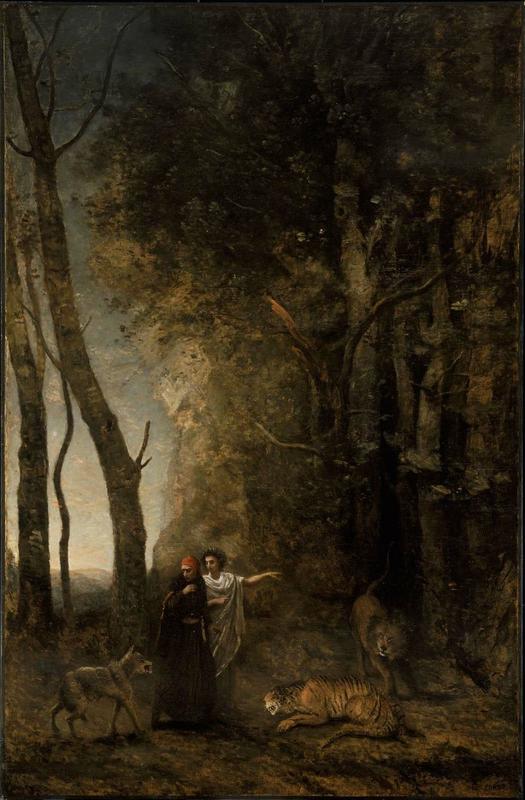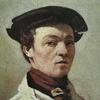More about Dante and Virgil

Contributor
Lions, and tigers, and bears, oh my! This is Dante's Wizard of Oz, his greatest work, his journey through his own accounting of his Christianity.
Dante and Virgil is the English name of Corot's painting, the original title of which adds the word paysage (landscape), indicating that it is not just the relationship between the two poets, but also the menacing forest and wild animals which occupy the center of the work, which is based on Dante's poem The Divine Comedy.
Dante and Virgil are a pair connected by the first artist's appreciation of the latter, across the bounds of time. More than that, Virgil appears, and states that he is "not a man, but once I was," to save Dante from the animal from whom he recoils in fear in Corot's painting: "a she-wolf who, all hide and bones, seemed charged with all the appetites that have made many live in wretchedness so weighed my spirits down with terror, which welled up at the sight of her, that I lost hope of making the ascent."
In the Divine Comedy, Dante Alighieri's meeting between himself and the ancient Roman poet Virgil is one of the first examples of time travel in literature, although the Hebrew oral law employed a similar technique over a thousand years earlier, transporting Moses forward in time, to the era of Virgil. Historians maintain that the figure Corot paints next to Dante is the actual historical poet Virgil, and that Dante's condemnation of Virgil, his hero, to the hellish realm of his poem, does not tarnish his admiration for his work. Corot paints the two poets here like Milo and Otis in the classic 1986 U.S. adaptation of the Japanese film about the two domestic animals on a grand adventure: the stately Roman Virgil with his white robes points the way into the story, while the frightened Dante looks at the grimacing wolf. Otis, the puppy, is Dante, and Milo, the brave kitten, is Virgil. But in Dante's story, his guide fails, because of that whole paganism vs. Christianity controversy. Corot portrays Dante as dependent on the wisdom of Virgil.
Dante and Virgil hung in the Paris Salon of 1859, one of more than one hundred paintings the artist submitted to the Salon over the years. Corot was so familiar with the Salon that he served on the jury in 1849 and many other times in subsequent years.
Sources
- Diawara, Manthia. "On David Hammons." Mar. 3, 2017, YouTube Video, https://youtu.be/WhwMYkSW564.
- Hollander, Robert. "DANTE'S VIRGIL: A LIGHT THAT FAILED." Lectura Dantis 4 (Spring 1989), https://www.brown.edu/Departments/Italian_Studies/LD/numbers/04/holland….
- "Inferno I." Princeton Dante Project, http://etcweb.princeton.edu/cgi-bin/dante/campuscgi/mpb/GetCantoSection….
- Kosman, Admiel. "When Moses Met Akiva." Haaretz, Sep. 24, 2004, https://www.haaretz.com/1.4684732.
- Print Quarterly XII. London: Print Quarterly Limited, 1996.
- Reinhard-Felice, Mariantonia. The Secret Armoire: Corot's Figure Paintings and the World of Reading. Swiss Confederation, represented by the Federal Office for Construction and Logistics, 2011.
- Tinterow, Gary, and Henri Loyrette. Origins of Impressionism. New York: Metropolitan Museum of Art, 1994.











